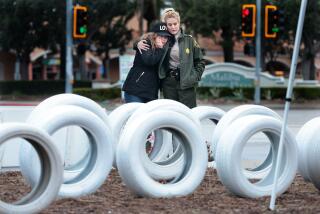Sensors, Cameras May Keep an Eye on Traffic
- Share via
Ventura County’s highways could be linked by a network of surveillance cameras and traffic sensors under a plan endorsed Friday by the county transportation board.
Board members told planners to scour federal agencies for nearly $800,000 in grant money to build the network.
Under the plan, up-to-the-second traffic patterns could be wired into upgraded call boxes and bounced by cellular frequencies into the atmosphere, with control centers in Ventura reeling in the data.
Any changes in the traffic flow would then be sent to the various agencies that monitor road conditions, and end up on the World Wide Web, driver information phone lines and, perhaps eventually, electronic signs along the Ventura Freeway.
“This is kind of the wave of the future,” said Steve DeGeorge, the transportation planner who wrote the plan approved for marketing Friday by the Ventura County Transportation Commission.
“Technology is going to be managing the highways,” DeGeorge said. “It’s already happening, and it will continue as long as technology advances.”
Larger metropolitan areas such as Los Angeles already employ sophisticated real-time tracking systems that alert California Department of Transportation engineers to changing road conditions.
But the pricey systems used in traffic-choked Los Angeles are not justified in semi-urban or rural areas such as Ventura County, DeGeorge said. Despite steady traffic on the Ventura Freeway and other local thoroughfares, Caltrans nonetheless designates them as rural highways.
“We’d love to have the super-dooper stuff from L.A., but it’s not cost-effective.” The Ventura County proposal, however, is relatively inexpensive. “Seven [hundred-thousand dollars] or $800,000 is not a whole lot when you’re talking about the federal government,” DeGeorge said.
Instead of updating traffic patterns each second, the local plan would be set up to inform road crews only when traffic slows below a certain speed. The sensors would monitor the county’s seven busiest highways: the Ventura Freeway, Pacific Coast Highway and California 23, 33, 118, 126 and 150.
The $793,500 in grant money would pay to modify 100 call boxes, buy 130 video cameras and install hundreds of road sensors.
“It would be a first step in getting some type of detection out there to verify if there are problems in that area,” said Terry Wong, a Caltrans engineer who works in the department’s intelligent-highway program.
*
“If we can determine and verify what problems are out there, we could respond that much faster,” Wong said. “That’s the key, to find out what’s going on and make the appropriate response.”
Such a system would have come in handy for local emergency response crews last winter, Wong said.
“In a major situation such as we had last year, your forces are stretched very thin,” he said. “The ability to use electronics and technology makes it that much easier to know what’s going on and how to prioritize our responses.
“It would be key to getting things open again,” he said.
California Highway Patrol officials also said the video and in-road sensor system would quicken their responses to accidents and other emergencies.
“It would definitely show us where problems are quickly and we could get there,” Ventura CHP Officer David Cockrill said. “If there are any impediments in the roadways, we could get officers there more quickly and get it cleared more quickly.”
*
Every major Ventura County highway was closed at one point last winter, with the Ventura Freeway shut down twice due to extensive flooding. Rockslides closed California 150 last January, and it remains closed.
“There was just no way to find out what was going on and to get traffic changed before the stoppages,” DeGeorge said.
The video and sensor system would allow Caltrans and CHP officials to reroute traffic before it backed up.
“If we had advance information that the 101 [Ventura Freeway] was closed in La Conchita, we could send a message to the changeable signs saying that the 101 is closed,” DeGeorge said.
Traffic information also would be sent immediately to the Ventura County Transportation Commission home page on the World Wide Web, and to the agency’s dial-a-route phone service.
And if the system proved worthwhile in Ventura County, it could be expanded to other semi-urban and rural communities.
“I believe the project will get funded,” said Wong, the Caltrans engineer. “It’s something that needs to be looked into because it would not only benefit Ventura County, it will help all the rural areas.”
More to Read
Sign up for Essential California
The most important California stories and recommendations in your inbox every morning.
You may occasionally receive promotional content from the Los Angeles Times.










